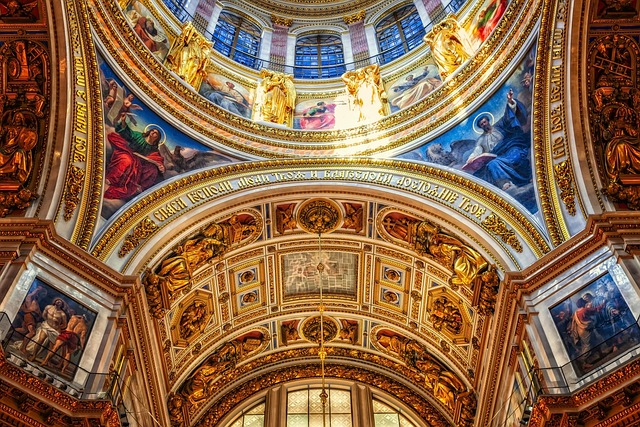Orthodox Christianity and Christianity are often used interchangeably, but they actually refer to two distinct branches of the Christian faith. Orthodox Christianity, also known as Eastern Orthodox Christianity, is one of the oldest and largest Christian traditions in the world. It traces its roots back to the early Christian Church and places a strong emphasis on tradition, liturgy, and the authority of the Ecumenical Councils. On the other hand, Christianity is a broader term that encompasses various denominations and traditions, including Protestantism and Catholicism. While both Orthodox Christianity and Christianity share a common belief in Jesus Christ as the Son of God and the Savior, they differ in terms of theology, worship practices, and ecclesiastical structure.
Table of Contents
History and Origins of Orthodox Christianity Vs Christianity
Orthodox Christianity and Christianity are two branches of the same tree, both rooted in the teachings of Jesus Christ. While they share many similarities, they also have distinct differences that have shaped their histories and origins.
Christianity, as a whole, emerged in the 1st century AD, following the life and teachings of Jesus Christ. It quickly spread throughout the Roman Empire, attracting followers from various backgrounds. The early Christians believed in the divinity of Jesus and his role as the savior of humanity. They emphasized faith in Jesus as the path to salvation and eternal life.
Orthodox Christianity, on the other hand, traces its origins back to the early days of Christianity. It developed in the Eastern part of the Roman Empire, with its center in Constantinople (modern-day Istanbul). The term “Orthodox” means “correct belief” or “right worship,” reflecting the emphasis on preserving the original teachings and practices of the early Christian Church.
One of the key differences between Orthodox Christianity and Christianity lies in their respective approaches to authority. In Christianity, the Pope, as the Bishop of Rome, holds a central role as the head of the Church. He is considered the successor of Saint Peter, to whom Jesus entrusted the keys of the kingdom of heaven. The Pope’s authority extends to all Christians worldwide.
In contrast, Orthodox Christianity does not recognize the Pope’s authority. Instead, it follows a decentralized structure, with each autonomous Orthodox Church led by its own patriarch or metropolitan. These leaders are equal in authority and work together in a collegial manner, making decisions through councils and synods.
Another significant difference between Orthodox Christianity and Christianity is their liturgical practices. Christianity has a diverse range of worship styles, with different denominations adopting various forms of worship, including contemporary services, traditional hymns, and charismatic expressions. The liturgical practices in Christianity can vary greatly from one church to another.
Orthodox Christianity, however, has a more uniform liturgical tradition. It places great importance on the preservation of ancient liturgical practices, which have been passed down through generations. The Divine Liturgy, the central act of worship in Orthodox Christianity, follows a set structure and is celebrated with reverence and solemnity. The use of icons, incense, and chant is also integral to Orthodox worship.
Despite these differences, both Orthodox Christianity and Christianity share a common foundation in the life and teachings of Jesus Christ. They both believe in the Holy Trinity, the divinity of Jesus, and the importance of faith in salvation. Both branches also hold the Bible as a sacred text, although the Orthodox Church includes additional books in its canon.
In conclusion, the history and origins of Orthodox Christianity and Christianity are intertwined, yet they have developed distinct identities over time. While Christianity has a centralized structure and diverse worship practices, Orthodox Christianity follows a decentralized structure and places great emphasis on preserving ancient liturgical traditions. Despite their differences, both branches share a common faith in Jesus Christ and strive to live according to his teachings.
Differences in Worship and Liturgy between Orthodox Christianity and Christianity

Orthodox Christianity and Christianity are two branches of the same tree, both rooted in the teachings of Jesus Christ. While they share many core beliefs, there are also significant differences in their worship and liturgy. In this article, we will explore these differences and shed light on the unique practices of Orthodox Christianity.
One of the most noticeable distinctions between Orthodox Christianity and Christianity lies in their worship styles. In Christianity, worship services are often characterized by a more informal and contemporary approach. Congregants gather in modern church buildings, accompanied by a worship band playing contemporary Christian music. The atmosphere is often relaxed, with people dressed casually and engaging in heartfelt prayers and singing.
On the other hand, Orthodox Christianity embraces a more traditional and formal worship style. Orthodox churches are adorned with intricate icons and beautiful frescoes, creating a sense of awe and reverence. The liturgy is conducted in a language that may be unfamiliar to many, such as Greek or Slavonic, adding to the sense of mystery and ancient tradition. The congregation stands throughout the service, participating in prayers, hymns, and chants led by the priest.
Another significant difference between Orthodox Christianity and Christianity is the role of the clergy in worship. In Christianity, the pastor or minister plays a central role in leading the congregation in worship. They deliver sermons, administer sacraments, and guide the spiritual life of the community. The congregation often has an active role in the service, with members volunteering to read scripture or lead prayers.
In Orthodox Christianity, the priest assumes a more prominent role in worship. They are seen as the mediator between the congregation and God, leading the faithful in prayer and administering the sacraments. The priest wears ornate vestments and performs intricate rituals, such as the blessing of the bread and wine during the Eucharist. The congregation looks to the priest for guidance and spiritual direction, placing a greater emphasis on the sacramental nature of worship.
The use of icons is another distinctive feature of Orthodox Christianity. Icons are religious paintings or mosaics depicting Christ, the Virgin Mary, and various saints. They are considered windows into the divine and are venerated by the faithful. In Orthodox worship, icons are prominently displayed in the church, and worshippers often kiss or touch them as an act of reverence. This practice is not as prevalent in Christianity, where the focus is more on the written word and personal interpretation of scripture.
Despite these differences, both Orthodox Christianity and Christianity share a common goal: to worship and honor God. While their worship styles and liturgical practices may vary, the underlying faith in Jesus Christ unites them. Both branches of Christianity seek to live out the teachings of Christ, love their neighbors, and spread the message of salvation.
In conclusion, the differences in worship and liturgy between Orthodox Christianity and Christianity are significant. Orthodox Christianity embraces a more traditional and formal approach, with a central role for the priest and a focus on icons. Christianity, on the other hand, tends to have a more informal and contemporary worship style, with an emphasis on personal interpretation of scripture. Despite these differences, both branches of Christianity share a common faith in Jesus Christ and strive to live out his teachings.
The Role of Icons and Religious Art in Orthodox Christianity Vs Christianity
Orthodox Christianity and Christianity are two branches of the same tree, both rooted in the teachings of Jesus Christ. While they share many core beliefs, there are also distinct differences that set them apart. One area where these differences become apparent is in the role of icons and religious art.
In Orthodox Christianity, icons hold a significant place in worship and devotion. These religious images are seen as windows into the divine, serving as a means of connecting with the spiritual realm. Icons are not mere decorations but are considered sacred objects that can facilitate a direct encounter with God. They are believed to be imbued with the presence of the holy figures they depict, such as Jesus, Mary, and the saints.
The veneration of icons is deeply ingrained in Orthodox tradition. Orthodox Christians believe that through icons, they can experience a tangible connection to the divine. Icons are often kissed, touched, and adorned with candles and incense during worship. They are also used as aids in prayer, with believers focusing their attention on the image as they seek a deeper connection with God.
In contrast, Christianity as a whole does not place the same emphasis on icons and religious art. While some Christian denominations do incorporate religious art into their worship, it is not as central to their faith as it is in Orthodox Christianity. For many Christians, the focus is more on the Word of God, as found in the Bible, and on personal prayer and reflection.
The difference in the role of icons and religious art between Orthodox Christianity and Christianity can be traced back to historical and cultural factors. The use of icons in Orthodox worship dates back to the early centuries of Christianity when the church was still united. Icons were seen as a way to visually communicate the stories and teachings of the faith to a largely illiterate population. Over time, the veneration of icons became deeply ingrained in Orthodox tradition and continues to be a defining characteristic of the faith.
In Christianity, the Protestant Reformation of the 16th century played a significant role in shaping the attitude towards icons and religious art. Many reformers, such as Martin Luther and John Calvin, criticized the veneration of icons as idolatry and sought to purify the church of what they saw as unnecessary and potentially distracting practices. This led to a more minimalist approach to worship, with a greater emphasis on the Word of God and personal piety.
Despite these differences, it is important to note that both Orthodox Christianity and Christianity share a common goal: to seek a deeper relationship with God and to live out the teachings of Jesus Christ. While the role of icons and religious art may vary, the underlying faith and devotion remain the same.
In conclusion, the role of icons and religious art in Orthodox Christianity differs from that in Christianity as a whole. Icons hold a central place in Orthodox worship, serving as a means of connecting with the divine. In contrast, Christianity places less emphasis on icons and religious art, focusing more on the Word of God and personal prayer. These differences can be traced back to historical and cultural factors, but ultimately, both branches of Christianity share a common goal of seeking a deeper relationship with God.
Understanding the Concept of Salvation in Orthodox Christianity Vs Christianity
Understanding the Concept of Salvation in Orthodox Christianity Vs Christianity
When it comes to understanding the concept of salvation, Orthodox Christianity and Christianity share many similarities, but also have some distinct differences. Both branches of the faith believe in the salvation of humanity through Jesus Christ, but they approach this concept in slightly different ways.
In Orthodox Christianity, salvation is seen as a process that involves the cooperation of both God and humanity. It is believed that through the incarnation, death, and resurrection of Jesus Christ, humanity was reconciled with God. However, this reconciliation is not automatic; it requires the active participation of individuals in their own salvation.
Orthodox Christians believe that salvation is a lifelong journey of transformation and growth in holiness. This process, known as theosis or divinization, involves the gradual restoration of the image and likeness of God in each person. It is through this process that individuals become united with God and experience eternal life.
In contrast, Christianity, as a broader term, encompasses various denominations and interpretations of the faith. While many Christian denominations share the belief in salvation through Jesus Christ, there is a greater emphasis on faith and grace as the means of salvation. Christians often believe that salvation is a gift from God that cannot be earned through good works or personal efforts.
For Christians, salvation is often seen as a one-time event that occurs when an individual accepts Jesus Christ as their Lord and Savior. This act of faith is believed to result in the forgiveness of sins and the assurance of eternal life. Once a person is saved, they are considered to be a part of the body of Christ and are encouraged to live a life that reflects their newfound faith.
While both Orthodox Christianity and Christianity believe in the importance of faith and the role of Jesus Christ in salvation, there are some differences in their understanding of the process. Orthodox Christianity places a greater emphasis on the transformative journey of theosis, while Christianity often focuses on the initial act of faith and the assurance of salvation.
Another difference lies in the role of good works in salvation. In Orthodox Christianity, good works are seen as an essential part of the process of salvation. They are not seen as a means to earn salvation, but rather as a response to God’s grace and a way to participate in the divine life. Christianity, on the other hand, often emphasizes that good works are a result of salvation rather than a means to attain it.
It is important to note that these differences in understanding salvation do not necessarily create divisions between Orthodox Christians and Christians. Both branches of the faith share a common belief in the salvific work of Jesus Christ and the importance of faith. The differences in emphasis and interpretation simply reflect the diverse expressions of the Christian faith.
In conclusion, understanding the concept of salvation in Orthodox Christianity versus Christianity reveals both similarities and differences. Both branches of the faith believe in the salvation of humanity through Jesus Christ, but they approach this concept in slightly different ways. Orthodox Christianity emphasizes the transformative journey of theosis and the role of good works, while Christianity often focuses on the initial act of faith and the assurance of salvation. Despite these differences, both branches of the faith share a common belief in the salvific work of Jesus Christ and the importance of faith in the process of salvation.
Conclusion
In conclusion, Orthodox Christianity and Christianity share a common foundation in the belief in Jesus Christ as the Son of God and the Savior of humanity. However, there are notable differences between the two. Orthodox Christianity places a strong emphasis on tradition, liturgy, and the authority of the Church, while Christianity as a whole encompasses a broader range of beliefs and practices. Additionally, Orthodox Christianity has a distinct hierarchical structure and sacramental theology. Overall, while both Orthodox Christianity and Christianity share many similarities, they also have distinct characteristics that set them apart.
For licensing reasons, we must provide the following notice: This content was created in part with the help of an AI.


